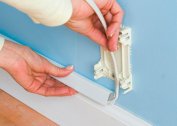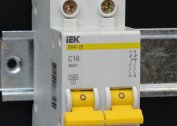Fluorescent lamps are commonly called fluorescent light sources. They are characterized by low power consumption, high service life. The emission spectrum is visually close to the solar. A significant disadvantage of fluorescent lamps is that they can not be connected directly to the network. It is necessary to use special ballasts (ballasts). Ballast devices create the possibility of a stable gas discharge and uniform light output during operation.
Lamp design
Incandescent and fluorescent lamps are connected in different ways, but any, even the highest quality light sources can burn. There are many reasons for the inoperability of fluorescent lamps. To identify them, you need to briefly familiarize yourself with the design and operation.
The principle of operation of fluorescent lamps is an electric discharge, which occurs in mercury vapor. The emitted ultraviolet light is converted into visible with a special substance - a phosphor, which is deposited on the inner surface of the lamp bulb.
In order for a gas discharge to occur, a high voltage is required, which is created when the lamp is turned on by using ballasts.
There are two fundamentally different types of ballasts:
- electromagnetic, in which a throttle and starter are used;
- electronic, assembled on electronic components.
Any mismatch in the parameters or failure of one of the elements leads to the complete inoperability of the lamp.
Electromagnetic ballast
 This type of ballast has the simplest design, which includes a choke and starter based on a neon lamp with movable contacts inside.
This type of ballast has the simplest design, which includes a choke and starter based on a neon lamp with movable contacts inside.
The presence of mechanical contacts is the weakest point of electromagnetic ballast. Starters fail most often, especially if the lamp often turns on. The cause of the failure of the throttle is the inter-turn circuit. In addition, the choke is a strong source of electromagnetic interference and can emit a strong hum.
Electronic ballast
 Electronic ballast equipment (electronic ballasts) converts the voltage of the supply network with a high frequency (of the order of tens and hundreds of kilohertz) in combination with rectification, therefore, when using such equipment, flicker is absent.
Electronic ballast equipment (electronic ballasts) converts the voltage of the supply network with a high frequency (of the order of tens and hundreds of kilohertz) in combination with rectification, therefore, when using such equipment, flicker is absent.
Electronic ballasts are small in size, weight and high reliability. Unfortunately, a number of manufacturers use low-quality components in production to reduce production costs, which leads to the failure of electronic ballasts.
The most common cause of electronic device failure is the loss of capacitance of electrolytic capacitors and the breakdown of junctions of high-voltage key transistors. Self-correction of the health of electronic components requires high qualifications and is not available to most consumers.
The same difficulties are associated with the manufacture of home-made devices for starting fixtures, although there are many schemes that can be used to increase the life of fluorescent lamps.
In addition to the malfunctions associated with the failure of the ballast, the absence of glow can be caused by the lamp itself. Fluorescent lamps have electrodes in their construction, which are coated with a special composition to facilitate starting.Over time, the composition burns out and a short-term high-voltage pulse, removed from the starter and throttle, is no longer able to ignite a gas discharge. In this case, re-ignition of the discharge occurs. Over time, the light starts blinking and stops starting.
Burnout of the phosphor leads to a gradual decrease in the brightness of the glow. Most quickly, this process occurs near the electrodes. In this case, the fluorescent lamp does not light up or its brightness is not uniform over the entire length of the lamp.
How to repair a fluorescent lamp
In most cases, the easiest way out is to replace the defective elements. You can check by installing a known-good element. A full-fledged repair of a fluorescent lamp is associated with a number of difficulties and requires a certain qualification and experience. Before disassembling the fluorescent lamp, you must make sure that it is disconnected from the network and that electricity is not supplied to it.
The easiest way to find a replacement for a faulty starter. You can make the lamp turn on by setting a button instead. This method is dangerous in that holding the button in excess of the necessary time can cause burnout of the electrode filament.
It is more difficult to use lamps without a choke. Several workable options for such inclusion have been developed. Most circuits use the principle of multiplying line voltage for a steady start. In these schemes, rectifier diodes and capacitor banks are used, which causes an increase in the dimensions of a home-made ballast. As a choke to limit the current, a powerful resistor or incandescent lamp of 25-40 W is used, depending on the power of the fluorescent lamp.
The advantage of resistors is small, but the problem is the high heat dissipation on it during operation. Incandescent lamps create an additional luminous flux, but since they operate at a reduced voltage, their service life is practically unlimited.
Separate circuitry solutions for electronic ballasts or multiplication schemes allow the use of bulbs with burnt filament. However, due to the fact that a high voltage is used during startup, and the current after ignition is slightly limited, the operating time of such fluorescent lamps is quite short.
Service life extension
 The service life of fluorescent lamps can be increased if you know the causes of their burnout:
The service life of fluorescent lamps can be increased if you know the causes of their burnout:
- Operation at low temperature leads to an increase in the duration of heating of the filament until a stable gas discharge occurs, as a result, the light fixture may burn out faster than the declared service life.
- Frequent switching on can also cause premature aging and burnout of the electrodes, since the inrush current is much higher than in steady state.
- Low-quality ballasts use simplified circuitry and, in addition to low cost, do not give any advantages.
Recommendations for increasing the service life:
- Do not use fluorescent lamps in rooms with a low temperature.
- Avoid frequent starts. The considered light sources consume a small amount of electricity, compared with incandescent lamps, so in some cases it makes sense to leave them on constantly.
- Use electronic ballasts with soft start. Such devices are somewhat more expensive and cause a delay in switching on (about 1-2 seconds), but they reduce the aging rate of the electrodes and allow frequent switching on.
- Purchase fluorescent lights from reliable manufacturers. The high cost is justified by the uptime.
Highly toxic mercury is contained inside the lamp bulb. Disposal of defective lamps must comply with legal requirements.




